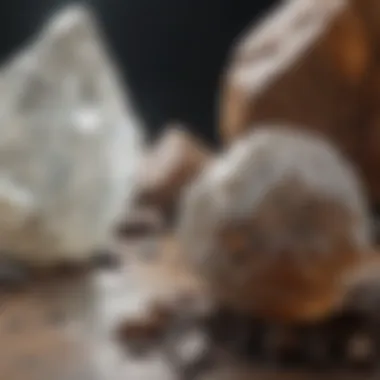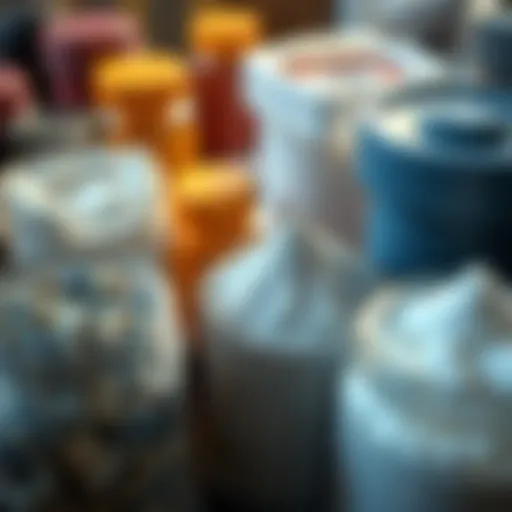Identifying Authentic Crystals: Guidelines and Insights


Intro
In recent years, the allure of crystals has captured the interest of many. This attraction stems from their inherent beauty and enigmatic origins. However, with this growing popularity comes a tendency for misrepresentation and imitation. Understanding how to identify genuine crystals becomes paramount for collectors and enthusiasts aiming to build an authentic collection.
The current market is flooded with imitations, often visually convincing but fundamentally different in properties and value. To truly appreciate these natural wonders, one must be equipped with the knowledge and skills necessary to discern the real from the fake. This guide seeks to illuminate the intricacies of crystal identification, providing clear and actionable insights that will enhance your collecting journey.
History and Origins
Crystals have been cherished throughout history, serving various roles across cultures and civilizations. Their origins are not just geological but also intertwined with human experiences and beliefs.
Overview of Collectibles, Rocks, and Fossils
Collecting rocks and fossils predates modern hobbies. Early civilizations utilized crystals for tools, ornaments, and healing. Each era brought a deeper understanding of these materials, transforming them from mere objects into symbols of power and spirituality. In ancient Egypt, for instance, lapis lazuli was prized for its deep azure hue and believed to promote protection and wisdom. In contrast, jade was revered in Chinese culture as a stone of purity and moral integrity.
These collectibles represent more than just physical objects; they embody stories of the earth's history and human interaction with nature. Understanding these narratives enhances the appreciation for authentic crystals.
Historical Significance and Cultural Impact
Throughout history, crystals have held significant cultural value. From their use in rituals to their representation in art and architecture, they have consistently inspired reverence among various cultures. For example, in medieval Europe, amethyst was considered a powerful stone that could prevent intoxication and promote clarity of mind.
Moreover, gemstones often played critical roles in trade and economy, influencing relationships between nations and communities. Their historical significance cannot be overlooked, as it provides context for their modern-day appeal. This rich background fosters an understanding of the value not only in monetary terms but also in cultural lore.
The appreciation for the origins and significance of crystals encourages collectors to pursue authenticity, ensuring that they cherish objects not only for their aesthetic beauty but also for their historical and cultural resonance.
Understanding Crystals and Their Significance
Crystals have captivated human interest for centuries. Their unique beauty, varied forms, and perceived properties have made them significant in numerous fields, from industrial applications to cultural and spiritual practices. Understanding crystals is not merely about appreciating their aesthetic qualities; it is essential for anyone engaging in the world of crystal collecting to grasp their significance.
The study of crystals encompasses various angles. For a collector, comprehending the science of crystals illuminates their formation and distinct characteristics. This understanding aids in identifying genuine specimens, which is critical when navigating the marketplace filled with imitations.
Additionally, the cultural and historical contexts surrounding crystals provide insight into their uses and value. Many ancient civilizations revered certain crystals for their believed healing properties or as talismans. Recognizing these historical perspectives can enhance one’s appreciation of a crystal beyond its physical form.
The significance of crystals extends into the realm of personal and emotional connections. Many individuals feel drawn to specific crystals. This affinity often leads to exploration of their metaphysical properties, which can enrich the collector's experience. Thus, understanding crystals represents a blend of scientific inquiry and personal exploration.
In this article, we will dissect these layers of significance, examining the properties of crystals, their scientific backgrounds, and their cultural histories. This comprehensive look will serve as a foundation for your journey in identifying authentic crystals and appreciating their multifaceted nature.
The Science Behind Crystals
Crystals are solid materials whose constituents, such as atoms or molecules, are arranged in a highly ordered, repeating pattern. This arrangement gives rise to the unique geometries and physical properties we observe. The formation of crystals typically occurs through processes such as cooling from a molten state or evaporation from a solution, leading to intricate structures.
The specific properties of a crystal are influenced by its chemical composition and the conditions under which it formed. For instance, quartz and calcite, both common in the crystal world, exhibit different structures and visual characteristics based on their elemental makeup. The science behind crystals also involves their optical properties. The way light interacts with these structures can determine clarity, brilliance, and color, which are essential factors in determining authenticity. Understanding these scientific principles lays the groundwork for any collector aiming to distinguish between authentic and imitation crystals.
Cultural and Historical Context of Crystals
Crystals hold a prominent place in various cultures and centuries of history. Many ancient civilizations utilized crystals not only for decoration but also for their perceived spiritual significance. For instance, the Egyptians used lapis lazuli as a symbol of protection and spiritual enlightenment. Similarly, in ancient China, jade was carved into amulets believed to bring good fortune and longevity.
Throughout history, several cultures have attached meanings and attributes to different crystals. These attributions can reflect the values and beliefs of societies. Today's crystal enthusiasts can gain insight from this vast tapestry of human experience, further enriching their collecting practices.
Modern usage continues in new forms—crystals are considered tools for energy healing in various holistic practices. The exploration of these beliefs and their historical roots can inform collectors about the deeper values assigned to their treasures.
In summary, the cultural and historical context imbues crystals with a significance that transcends their physical beauty. Understanding this context allows collectors to approach their collections with respect and knowledge, considering crystals as part of a larger narrative that connects humanity's past with present practices.
Common Types of Crystals
Understanding the common types of crystals is essential for rock and fossil collectors. Differentiating between natural, synthetic, and imitation crystals can profoundly affect how one collects, appreciates, and values these specimens. This section provides an overview of each type, highlighting their unique attributes and implications for collectors. Gaining familiarity with these categories enables collectors to make informed decisions and ensures richer experiences when acquiring crystals.
Natural Crystals
Natural crystals originate from geological processes. They form in the earth through cooling and solidification of magma or through evaporation of minerals. As a result, their structures carry the history of their environment. Collectors often seek natural crystals for their unique characteristics and beauty. Natural crystals like quartz, amethyst, and citrine are praised for their aesthetic qualities and purported metaphysical properties.
Natural specimens are generally considered more valuable than synthetic or imitation crystals. However, value is not solely based on appearance; rarity also plays a critical role. Collectors should be attentive to the specific type and formation environment to help ascertain authenticity.


Synthetic Crystals
Synthetic crystals are man-made, produced in a laboratory setting to replicate the properties of natural crystals. Examples include cubic zirconia and lab-grown diamonds. While they can share similar physical and chemical properties with their natural counterparts, synthetic crystals typically lack the unique individuality that comes with natural growth processes.
For collectors, understanding synthetic crystals is crucial. They are often less expensive, which can be appealing, but it is vital to know they may not hold the same value as natural specimens in the collector's market. Furthermore, some collectors prefer natural specimens for their authenticity and uniqueness. Thus, knowledge of synthetic crystals helps in making informed purchasing decisions.
Imitation Crystals
Imitation crystals are designed to resemble genuine crystals but are created from materials that lack the properties of natural crystals. Common examples include glass imitations and plastic stones. While imitation crystals can be visually appealing, they do not possess the mineral composition, structure, or any metaphysical properties attributed to natural crystals.
Collectors should be cautious with imitation crystals, as they may often be mislabeled as genuine ones. Understanding this distinction is vital to ensure that collectors do not overpay for what may be a mere reproduction. This knowledge can protect against unscrupulous vendors and help maintain a high standard in a collection.
Physical Characteristics of Genuine Crystals
Understanding the physical characteristics of genuine crystals is vital for anyone interested in crystal collecting. These characteristics serve as key indicators of authenticity, helping collectors distinguish real specimens from synthetics and imitations. By examining features such as clarity, color, and texture, enthusiasts can make informed decisions. This knowledge not only enhances the collecting experience but also protects against fraudulent practices in the market.
Clarity and Transparency
Clarity and transparency are fundamental properties of genuine crystals. When evaluating clarity, one should be on the lookout for inclusions or blemishes. Natural crystals often contain unique internal characteristics that serve as fingerprints of their authenticity. The presence of these inclusions is not necessarily a flaw; rather, it contributes to the individuality of each specimen.
Transparent crystals allow light to pass through with minimal interference, revealing their inner beauty. A crystal's brilliance often reflects its quality. For example, a clear quartz crystal is valued more highly than one with significant cloudiness. It is essential to observe the light reflection and refraction patterns as these can indicate whether it is a genuine stone or a glass imitation.
Color and Appearance
Color plays a crucial role in identifying genuine crystals. The hues present in natural crystals can provide vital clues about their origins and types. However, one must approach color carefully. Many synthetic crystals mimic natural colors, making it important to analyze them deeply. Natural crystals often display a range of tones even within a single specimen, providing a depth that is difficult to replicate in imitations.
The intensity and saturation of the color can also signal authenticity. For instance, a deep blue sapphire should possess richness in color without being overly uniform. Imitation stones may have unrealistic coloration or a flat appearance that lacks natural variation. Knowing the standard colors associated with specific stones can aid collectors significantly.
Texture and Surface Quality
Lastly, texture and surface quality are significant when assessing crystal authenticity. Genuine crystals exhibit unique textures formed naturally over time. Smooth surfaces, for instance, might indicate a well-formed crystal, whereas scratches or abrasions can suggest either wear or poor treatment methods. The feeling of a crystal in hand provides additional insight; some may be rough, while others are polished to achieve smoothness.
The appearance of striations or grooves can also indicate that a crystal is natural. Many synthetic versions smooth away these features for a flawless look. Collectors should seek to understand these textural nuances, as they can often differentiate between authenticity and imitation. Therefore, the evaluation of texture and surface quality must form an integral part of any rigorous examination of crystal specimens.
"Recognizing the subtle differences in clarity, color, and texture can drastically alter one's ability to identify genuine crystals among fakes."
Testing Techniques to Determine Authenticity
When it comes to collecting crystals, ensuring their authenticity is paramount. With a market rich in diverse offerings, enthusiasts often face challenges in distinguishing genuine stones from their synthetic or imitation counterparts. Testing techniques serve as essential tools in this journey. These methods provide a practical approach to validating the authenticity of crystals, ultimately preserving their value and integrity. Employing these tests not only enhances the collector's confidence but also enriches the appreciation of these natural formations.
The Scratch Test
The scratch test is one of the simplest yet effective ways to evaluate crystal authenticity. This method relies on the principle of hardness. Crystals have different hardness levels, which are standardized by Mohs scale. To conduct this test, take an object with a known hardness, such as a glass or metal tool, and gently scratch the surface of the crystal.
If the crystal scratches easily, it may be a sign that it is a synthetic material, while genuine crystals typically resist scratches. However, care must be taken as using overly hard objects can damage the crystal. Therefore, it is wise to choose materials that will not cause irreversible harm to the stone.
The Water Test
Another straightforward test involves the water test. This technique evaluates the response of crystals to water, particularly regarding their solubility. Genuine crystals generally do not dissolve or break down in water, whereas some imitation stones, notably those made of resin, might exhibit different behaviors.
To perform this test, immerse the crystal in clean water for a specific duration. Afterward, observe whether any changes occur, such as cloudiness or degradation. This method is especially useful for visually identifying some lower-quality imitations. It is important to note that some genuine crystals can be affected by water, so this technique should be used cautiously.
Heating Tests
Heating tests are more intrusive but can yield valuable insights regarding a crystal’s authenticity. This method evaluates how a crystal responds to heat exposure. First, heat a minimal section of the crystal using a lighter or torch for a short period. Genuine crystals typically withstand heat well, while synthetic materials might discolor, melt, or show signs of structural change.
While conducting heating tests, do ensure that the test environment is safe, and always handle crystals with care. The risks involved necessitate experienced judgment to prevent damage. Use this method as a supplementary test, rather than the sole criterion for authenticity.
Refractive Index Testing
Refractive index testing offers a more scientific approach to determine crystal authenticity. The refractive index describes how light bends when it passes through the crystal. By using a refractometer, collectors can measure this property. Each type of crystal has a characteristic refractive index, and comparing these measurements can assist in distinguishing genuine stones from imitations.
This method requires specialized equipment and knowledge of the expected refractive indices for the specific types of crystals under observation. While it is less accessible than other testing techniques, it provides a high degree of accuracy, thus proving invaluable for serious collectors.


The methods of testing, when applied methodically, pave the path to identifying authentic crystals with greater precision. An informed approach not only safeguards collectors against fraud but also enhances the overall collecting experience.
The Role of Certified Gemologists
When it comes to identifying authentic crystals, the role of certified gemologists cannot be overstated. These professionals possess the specialized training and knowledge necessary to evaluate the qualities of various crystals. Their expertise ensures that collectors and enthusiasts are making informed decisions regarding their purchases. Gemologists apply scientific techniques and industry standards to ascertain the authenticity of gemstones. This aspect is crucial, as many imitations can easily mislead buyers who lack the requisite knowledge.
One primary function of gemologists is to provide a thorough analysis of crystals that may look genuine but are, in fact, synthetic or imitation. This process typically involves advanced testing methods unfamiliar to most collectors. Certified gemologists draw on a comprehensive understanding of mineral properties, optical characteristics, and the nuances that differentiate natural stones from artificial ones.
Additionally, having a trained gemologist on your side can greatly enhance the investment potential of your collection. A verified assessment adds value to your stones and provides a level of assurance to other collectors or buyers in the future. Knowing that a gemologist certifies your crystals as authentic builds trust and facilitates smoother transactions when you wish to sell or trade.
To fully appreciate these advantages, it is necessary to recognize the importance of finding a qualified gemologist.
Reputable Sources for Buying Crystals
When it comes to collecting crystals, choosing reputable sources is critical. Not only does this ensure authenticity, but it also supports ethical practices within the crystal industry. This section will explore various avenues for acquiring crystals, including local gem shows, online retailers, and working with local dealers. Understanding these channels empowers collectors to make informed choices, protecting their investments and promoting sustainable practices in the process.
Local Gem Shows and Mineral Exhibits
Local gem shows and mineral exhibits provide an excellent opportunity for collectors to find authentic crystals. These events often showcase a wide variety of crystals, minerals, and fossils from different regions. Since these shows typically feature multiple vendors, collectors can compare prices and quality in person.
Here are some benefits of attending these events:
- Face-to-Face Interactions: Meeting vendors directly allows for discussions about sourcing and authenticity. Collectors can gain insights into the origins of the crystals.
- Hands-On Examination: Examining crystals in person offers a chance to assess their clarity, color, and overall appearance more accurately than through online images.
- Community Building: These events are an opportunity to connect with fellow collectors, fostering a sense of community and sharing knowledge about collections.
Before attending a show, research the exhibitors and their reputations. This can include checking social media, reviews, or forums like reddit.com for feedback.
Online Retailers and Marketplaces
Online shopping has become a popular avenue for acquiring crystals. There are numerous retailers and marketplaces offering a diverse range of stones. However, it is vital to choose trustworthy platforms to avoid purchasing imitation crystals.
Consider the following when shopping online:
- Reputation and Reviews: Look for established retailers with positive customer feedback. Websites like en.wikipedia.org may provide information on well-known gem sellers.
- Return Policies: Retailers with reasonable return policies are often more trustworthy. This ensures you can return any items that do not meet your expectations.
- Quality Assurance: Some retailers provide certificates of authenticity, indicating that the crystals have been independently verified.
Major online marketplaces can offer great deals, but buyer beware. Always take the time to research sellers before making any purchases.
Working with Local Dealers
Local dealers can be an invaluable resource for collectors. They often possess deep knowledge of the crystals they sell and can provide insights that online platforms might lack. Building a relationship with reputable local dealers may lead to unique opportunities and better deals.
When working with local dealers, keep the following tips in mind:
- Ask Questions: Inquire about the sources of their crystals and their knowledge of specific types. A good dealer is happy to share both their passion and expertise.
- Observe Store Policies: Ethical dealers typically have clear policies regarding sourcing and customer satisfaction. Ensure they are transparent about how they acquire their crystals.
- Follow Recommendations: Seek referrals from other collectors or forums like facebook.com where collectors share their experiences and suggest reliable dealers.
By choosing to purchase from local dealers, you not only gain quality crystals but also support small businesses in your community.
Ethical Considerations in Crystal Collecting
Understanding ethical considerations in crystal collecting is essential for enthusiasts who wish to engage in the hobby responsibly. Crystals carry both aesthetic value and potential investment opportunity. Yet, the methods and practices of sourcing them directly affect the environment and communities involved in their extraction. Hence, embracing ethical practices is crucial in honoring the integrity of crystal collecting. It ensures that collectors are not only responsible for their selections but also contribute positively to the sustainability of these natural resources.
Sourcing Practices and Their Impact
The origins of crystals can greatly influence their authenticity and value. Ethical sourcing means purchasing crystals from suppliers who prioritize fair practices in harvesting. This often requires awareness about where and how the specimens are obtained. For instance, crystals extracted from regulated mines are typically more reliable than those from illegal operations.
When sourcing, consider these key practices:
- Traceability: Understanding the journey of a crystal from mine to market can reveal its ethical standing.
- Local Impact: Support suppliers who invest in their communities and enhance local economies. Collectors should seek out vendors who fund educational or social programs.
- Environmental Considerations: The mining process can have significant environmental repercussions. Choosing sources that employ sustainable methods reduces ecological harm.
Overall, sourcing practices can greatly impact both the value of crystals and the conditions under which they are obtained. By choosing ethically sourced minerals, collectors help to promote sustainable practices within the industry.
Supporting Sustainable Mining Operations
Sustainable mining operations are vital for maintaining ecological balance and ensuring that crystals can be available for generations to come. Supporting such practices not only safeguards the environment but ensures fair labor conditions for workers in the mining sector.


To support sustainable mining, consider the following approaches:
- Research Mines: Investigate the mining companies before purchasing. Responsible operations often have certifications or documentation to showcase their practices.
- Buy from Ethical Retailers: Seek out dealers who guarantee that their crystals come from sustainable sources. These retailers often have a commitment to responsible practices.
- Advocacy: Encourage awareness in the community about the importance of sustainability in mining. Use platforms to share information and advocate for responsible sourcing.
At the heart of collecting lies the desire to appreciate the beauty of nature. By supporting sustainable mining operations, collectors can ensure that this appreciation does not come at the cost of the planet or the communities involved.
“By prioritizing ethical sources, each collector plays a role in shaping a more sustainable future for crystal collecting.”
Engaging in ethical crystal collecting not only enhances one's collection but reflects a commitment to responsible stewardship of natural resources and the communities that contribute to their beauty.
Maintaining Your Crystal Collection
Maintaining your crystal collection is a critical aspect that deserves careful attention. Crystals are not only visually captivating but also can be seen as investments and personal treasures. Proper maintenance ensures their longevity and preserves their authenticity. Neglecting this responsibility can lead to damage, loss of luster, and even physical deterioration. Therefore, adopting effective cleaning techniques and employing suitable storage solutions is essential for any collector.
Cleaning Techniques for Crystals
Cleaning your crystals is a necessary practice that enhances both their appearance and energy. Different crystals require different cleaning methods due to variations in hardness and susceptibility to damage. Here are some recommended techniques:
- Gentle Soap and Water: This is a safe method for most crystals. Use a soft cloth or sponge with mild soap and warm water. Avoid strong chemicals that can mar the surface of the crystals.
- Salt Water: Certain crystals benefit from a saltwater bath. Mix sea salt with water and soak the crystals for several hours. Rinse thoroughly to remove salt residue, which can cause long-term damage.
- Smudging with Sage: A holistic method, smudging can cleanse crystals of negative energies. Pass the stones through the smoke of burning sage. It is effective and non-intrusive.
- Sonic Cleaners: For collectors with a vast array of crystals, electronic sonic cleaners can gently remove dirt and grime without risk of damaging the stones.
Be mindful to research specific stone properties beforehand, as some minerals like selenite may be water-soluble and could be damaged by either liquid cleaning methods.
Storage Solutions to Prevent Damage
Proper storage can prevent many issues that collectors face. Storing crystals correctly minimizes the risk of scratches, chips, and environmental damage. Here are some effective strategies for safeguarding your collection:
- Individual Pouches or Boxes: Each crystal should have its own pouch or box. Soft materials will prevent scratching against one another, and boxes with dividers help maintain organization.
- Avoid Direct Sunlight: Some crystals can fade or change color when exposed to prolonged sunlight. Store them in a cool, dark location to prevent alteration.
- Climate Control: Crystals should not be stored in damp or excessively dry environments. Control temperature and humidity to maintain their integrity.
- Use Display Cases: For crystals that you wish to showcase, utilize display cases made of glass to protect from dust while allowing visibility. Ensure air circulation within display areas to avoid humidity buildup.
The way you maintain your crystals reflects not only their importance to you but also your commitment to preserving their beauty and authenticity for future generations.
The Value of Crystals: Beyond Aesthetics
Crystals possess a significance that extends far beyond their visual appeal. Understanding their value encompasses various dimensions, including market trends, investment potential, and ethical considerations. This reflection not only benefits collectors and enthusiasts but also highlights the role crystals play in culture and economy.
Market Trends in Crystal Collecting
The landscape of crystal collecting has transformed over the years, characterized by increasing interest from diverse groups. Initially, this hobby attracted gem enthusiasts physically drawn to the beauty of the stones. Today, its appeal has broadened considerably. Many collectors seek crystals for holistic purposes, embracing their purported metaphysical properties. This trend has been fueled by social media, where platforms showcase stunning visuals of crystals, inspiring many to invest in these natural formations.
In recent years, data shows a significant boom in the market for crystals. The growing awareness about the benefits of natural materials has further solidified this trend. Various factors drive this market:
- Online marketplaces have made purchasing easier, allowing enthusiasts to access a global range of crystals.
- Limited editions and unique specimens often command a higher price, leading to increased competition among collectors.
- The rise of eco-consciousness has pushed consumers towards ethical and sustainable sourcing, adding another layer of complexity to the market.
Adapting to these trends is vital for collectors who wish to invest wisely. As interests shift, so shall the value associated with different types of crystals. For instance, once overlooked stones may suddenly gain popularity, affecting their prices. This volatility necessitates continuous research and adaptability among aficionados.
Investment Potential and Risks
Investing in crystals can be both rewarding and risky. Their investment potential is largely determined by various factors. First, unique and high-quality specimens typically maintain or increase in value over time. Crystals like amethyst or diamonds are classic examples of well-regarded gemstones that have shown appreciation in value historically. However, financial success in this realm demands keen knowledge of the market and properties of the stones.
Moreover, the inherent risks associated with crystal investment require attention. The following elements are vital for collectors:
- Market Volatility: Like any collectible, the value of crystals can fluctuate significantly based on trends and public interest.
- Authenticity Concerns: The rise of synthetics and imitations complicates evaluations. Investors need to ensure that they make purchases from reputable sources.
- Long-term Commitment: Crystals often need time to appreciate in value, similar to art or real estate. Investors must be prepared for a prolonged commitment before seeing financial returns.
Culmination: Ensuring Authenticity in Crystal Collection
In the realm of crystal collecting, ascertaining the authenticity of your pieces is paramount. The market is teeming with options, both genuine and counterfeit, and understanding the distinctions ensures that collectors can make informed choices. This article has provided insights into the various facets of identifying real crystals, enriching your knowledge and enhancing your collecting experience.
Crystals carry not only aesthetic value but also historical and cultural significance. By emphasizing the importance of authenticity, collectors can safeguard their investments. This ensures that the crystals in their collection truly represent what they claim to be. An authentic crystal can offer a deeper connection to nature, embodying geological history and energy that fakes simply cannot replicate.
Benefits of Ensuring Authenticity
- Increased Value: Genuine crystals tend to appreciate over time, while synthetic or imitation crystals will often lose value. Understanding the authentic nature of your collection helps in asset management.
- Cultural Appreciation: Many crystals hold historical and cultural significance. By ensuring authenticity, collectors honor the traditions associated with these natural wonders.
- Personal Satisfaction: Knowing that the crystals you possess are real can enhance your enjoyment and connection to your collection.
Key Considerations
- Investment in Knowledge: Learning about the various methods for identifying crystals is crucial. The tests discussed in this guide, alongside the help of certified gemologists, can offer clarity in an often confusing market.
- Ethical Sourcing: Collecting crystals ethically contributes to sustainability and responsible practices. This can often influence value and sentimental worth attached to a crystal.
- Regular Evaluation: As the market evolves, being proactive about evaluating your collection can ensure continued authenticity.
"In the journey of crystal collecting, authenticity is not just a goal; it is a commitment to respecting the Earth's geological gifts."
In summary, identifying authentic crystals is about more than simple verification. It involves a nuanced understanding of the market, ethical considerations, and a dedication to respecting natural beauty. As you continue your exploration in the world of crystals, prioritize the authenticity of your collection. This commitment not only safeguards your investment but also enriches your appreciation for these magnificent treasures.



